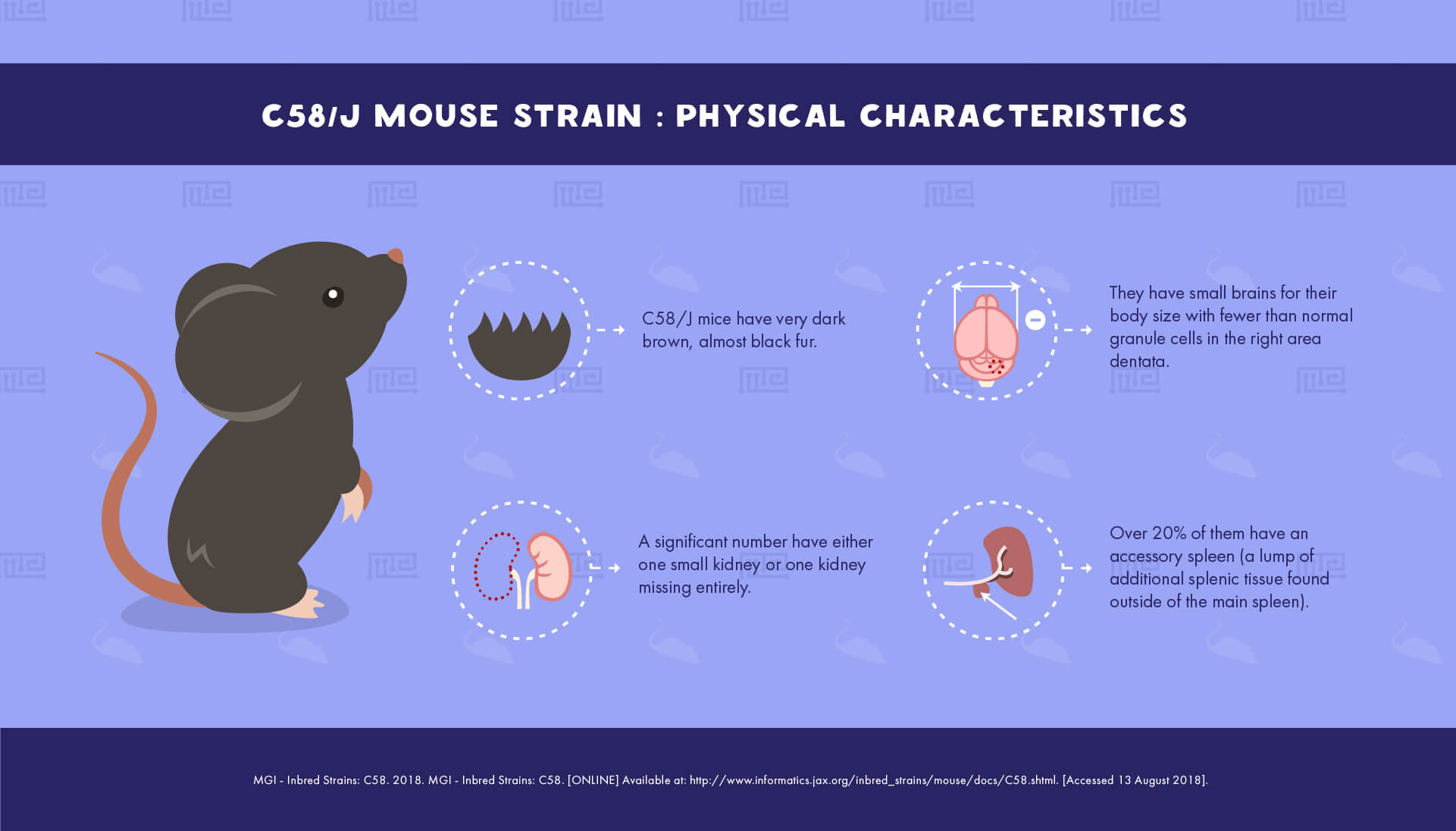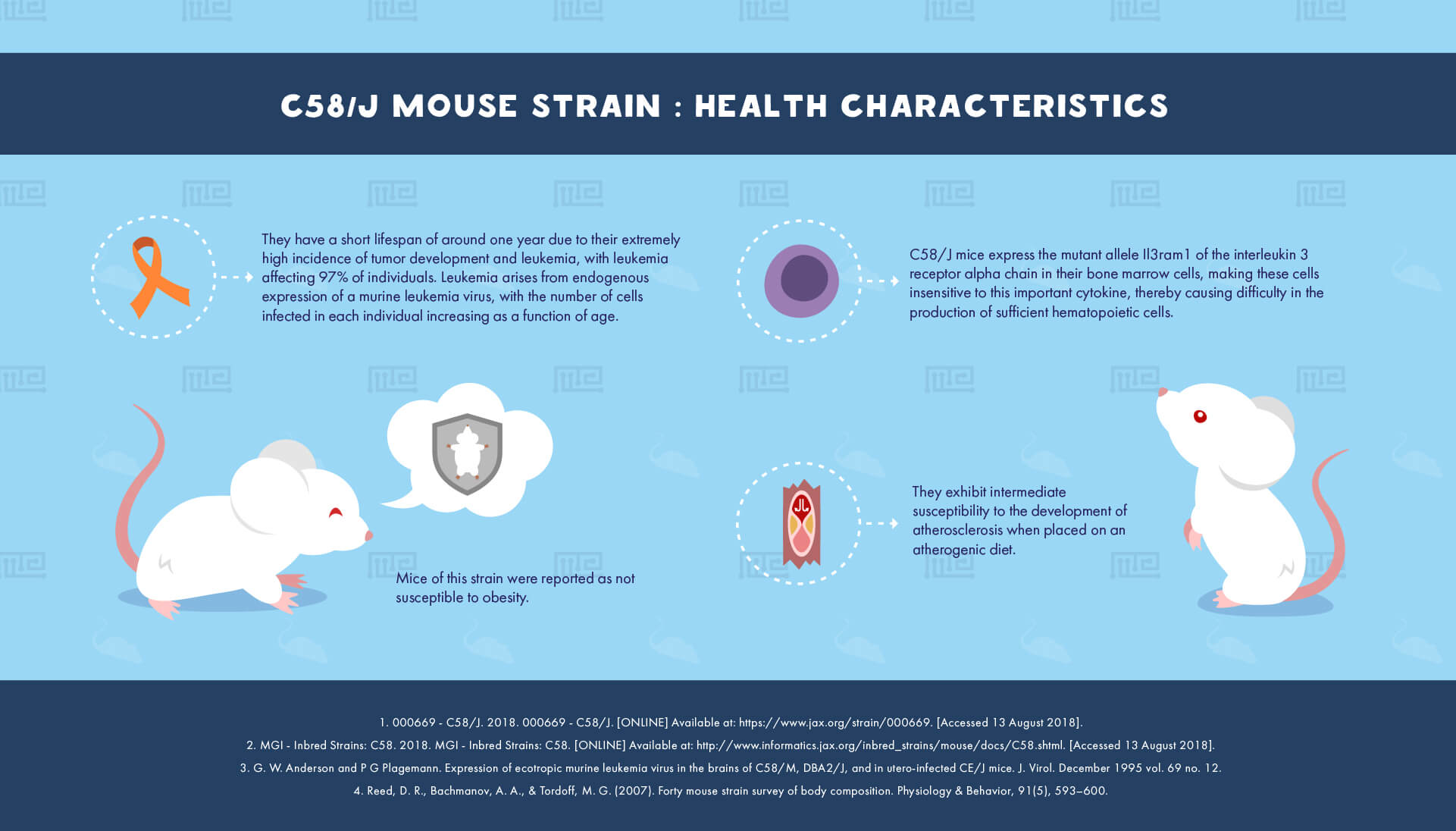Overview
C58/J is a strain of inbred mouse model that is related to the more commonly used C57BL family of strains. The C58/J mice are most commonly used in cancer research, due to their very frequent development of leukemia.
History
The original C58 strain was developed by MacDowell in 1921. One of the parents of this strain was also used as a progenitor for C57BL. The mice later came to the Jackson Laboratory, where the current C58/J strain was developed.[1]
Physical Characteristics
C58/J mice have very dark brown, almost black fur. They have small brains for their body size with fewer than normal granule cells in the right area dentata, and a significant number have either one small kidney or one kidney missing entirely. Over 20% also have an accessory spleen (a lump of additional splenic tissue found outside of the main spleen).[2]
Behavioral Characteristics & Handling
A Canadian study[3] of the comparative ease of handling of various mouse strains reports that C58/J was very placid, although not as placid as the more commonly used C57BL/6J and BALB/cByJ strains. Squeak frequency when held was low, and capture and holding was generally quite easy, with very little struggling or evasive behavior.
Reports on the performance of C58/J mice in the T maze test (used to assay spatial learning and memory) are inconsistent, with the Jackson Laboratory reporting both poor[1] and good[2] performance in different sources. Breeding performance for this strain is described as poor, and social preference as low.[2] It also shows increased stereotypy in motor behaviors compared to most strains.[1][2]
Health Characteristics
Lifespan for individuals of this strain is short at around one year.[2] This is due to their extremely high incidence of tumor development and leukemia, with leukemia affecting 97% of individuals.[1][2] Leukemia arises, like in the AKR/J strain, from endogenous expression of a murine leukemia virus, with the number of cells infected in each individual increasing as a function of age.[4]
C58/J mice express the mutant allele Il3ram1 of the interleukin 3 receptor alpha chain in their bone marrow cells, making these cells insensitive to this important cytokine. As a result, the mice find it difficult to produce sufficient hematopoietic cells.[1]
C58/J mice also exhibit intermediate susceptibility to the development of atherosclerosis when placed on an atherogenic (high fat, high cholesterol) diet.[2] Although in one study of mouse body composition by strain, mice of this strain were reported as having the lowest body fat percentage of all strains measured,[5] suggesting they are not susceptible to obesity.
Major Experimental Uses
Its extremely high incidence of leukemia has meant this strain has proven most useful in cancer research.[1][2]
The C58/J mice’s display of low sociality and stereotypical motor patterns have also raised interest in its use as a model for autism spectrum disorders.[6] Several studies have characterized the social deficits and early-developing repetitive motor behaviors of this model and compared them favorably to the human autistic phenotype.[6][7][8]
Like many other inbred mouse strains, C58/J mice are homozygous for the Cdh23ahl mutant cadherin allele which confers hearing loss. As a result, mice of this strain are also used in the study of hearing deficits.[1]
References
- 000669 – C58/J. 2018. 000669 – C58/J. [ONLINE] Available at: https://www.jax.org/strain/000669. [Accessed 13 August 2018].
- MGI – Inbred Strains: C58. 2018. MGI – Inbred Strains: C58. [ONLINE] Available at: http://www.informatics.jax.org/inbred_strains/mouse/docs/C58.shtml. [Accessed 13 August 2018].
- Wahlsten, D. Metten, P. Crabbe, JC. 2003. A rating scale for the wildness and ease of handling laboratory mice: results for 21 inbred strains tested in two laboratories. Genes, Brain and Behavior. 2; 71-79.
- W. Anderson and P G Plagemann. Expression of ecotropic murine leukemia virus in the brains of C58/M, DBA2/J, and in utero-infected CE/J mice. J. Virol. December 1995 vol. 69 no. 12.
- Reed, D. R., Bachmanov, A. A., & Tordoff, M. G. (2007). Forty mouse strain survey of body composition. Physiology & Behavior, 91(5), 593–600.
- Blick MG, Puchalski BH, Bolanos VJ, Wolfe KM, Green MC, Ryan BC. Novel object exploration in the C58/J mouse model of autistic-like behavior. Behav Brain Res. 2015 Apr 1;282:54-60.
- Muehlmann, A., Edington, G., Mihalik, A., Buchwald, Z., Koppuzha, D., Korah, M., & Lewis, M. (2012). Further characterization of repetitive behavior in C58 mice: Developmental trajectory and effects of environmental enrichment. Behavioural Brain Research, 235(2), 143–149.
- Ryan, B. C., Young, N. B., Crawley, J. N., Bodfish, J. W., & Moy, S. S. (2010). Social Deficits, Stereotypy, and Early Emergence of Repetitive Behavior in the C58/J Inbred Mouse Strain. Behavioural Brain Research, 208(1), 178.


